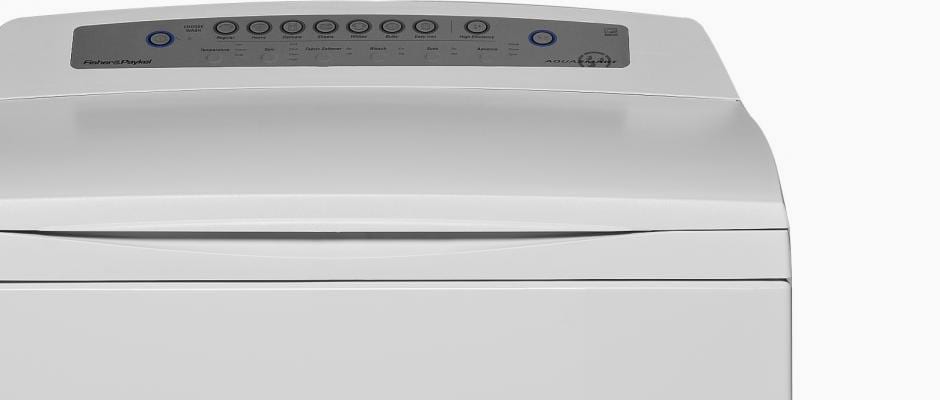Introduction
In our scientific tests, it excelled both in terms of stain removal and ease of use. Its ten year motor warranty is also impressive, though not unprecedented. As for drawbacks, its overly-simplified control panel lacks a time display, dirt removal is subpar, and the “AquaSmart” moniker is undeserved, considering how much water this top-loader uses.
Design & Usability
{{section_header}}{{section.name}}{{/section_header}}
Easy to use, but no wash timer
This appliance has foolproof but spartan controls. Like the speedometer on your grandfather's Buick LeSabre, the {{product.name}}'s control panel is laid out horizontally. The top tier is home to wash cycles, with an individual button for each. Beneath are the wash options, which scroll through menus. It's extremely easy to use.
Conspicuously absent for a washer in this price range is a timer that shows how many minutes are left in a wash. The "advance" feature is pretty cool, though, letting you skip through parts of a wash cycle if you're in a hurry. It's also easy to load and unload, since there's no agitator that clothes might get wrapped around. Just watch out for that big door.
{{photo_gallery "Front Image", "Controls 1 Photo", "Controls 2 Photo", "Drawer Photo", "Lint Trap Photo", "Interior Photo", "Interior Detail Photo", "Sides Photo", "Sides Detail 1 Photo", "Side Detail 2 Photo", "Back Photo", "Back Detail Photo"}}
Performance & Features
{{section_header}}{{section.name}}{{/section_header}}
The Regular cycle destroys stains.
The {{product.name}} did well universally when it came to stain removal. Even tough oil and grease stains were no match for this machines Regular cycle, which left our standardized stain strips closer to pure white than many other washers we’ve tested. However, the AquaSmart’s Delicate cycle isn’t going to remove any tough stains, though it will brighten your less-durable laundry without damaging it.
Sadly, there is no "quick" cycle, nor any way to configure an existing cycle to take less time. If you're in a hurry, it's possible to push the "advance" button to skip to the next step of a cycle, but be warned—performance will inevitably suffer. No cycle took longer than an hour, though, which is reasonable.
Finally, though the AquaSmart uses less water than washers designed a decade ago, it wasn't appreciably more efficient than any other modern top-loader we've tested. Moreover, it uses about twice as much water as numerous front loading units we've tested. Oh, and don't get too excited about Fisher & Paykel's similarly-named EcoSmart top loader—it proved just as thirsty.
Conclusion
{{section_header}}{{section.name}}{{/section_header}}
Fisher & Paykel had an interesting take on the top-loading washer.
On sale for around $775, the {{product.name}} does a great job getting stains out of clothes, but struggles with other aspects of a washer. Combined with its lackluster control panel and a thirst for water that belies its name, it's not a great value for such a high price.
The MSRP is even costlier if you consider this machine's high yearly operating cost. Assuming that your water and energy costs are around the national average, running this appliance for a year will set you back more than $61.
Science Introduction
{{section_header}}{{section.name}}{{/section_header}}
The {{product.name}} felt like it was designed by someone who wanted to disregard general conventions. For example, the lid covers the entire surface of the top area. Fisher & Paykel has a style all their own. This Aquasmart was quite sharp, powering through stains, even oily ones. It surprised us further by having great water retention numbers. However, a clustered control panel and a high initial price makes this a hard sell.
Cleaning & Cycle Duration
{{section_header}}{{section.name}}{{/section_header}}
All ye stains, beware.
The {{product.name}} excelled at stain removal. The Regular cycle proved the best that this washer has to offer, leaving our standardized stain strips closer to pure white than many other washers we’ve tested. The Heavy Duty performed slightly better, but probably isn't worth the extra five minutes. We came to this conclusion by using stain strips. These pieces of cloth have stained patches—substances you can probably find in your own home, such as oil and cocoa.
None of the cycles took more than an hour. When a cycle finished, we removed the stain strips and looked at them under a light spectrometer. A beam of light reflecting off the stain patch tells us how much of the stain is gone.
{{photo_gallery "Science Section 1 Images"}}
Efficiency
{{section_header}}{{section.name}}{{/section_header}}
Aquasmart or Aquadunce?
The {{product.name}} didn't live up to its name. It used about as much water as other top-loaders. The Regular cycle used more than 16 gallons of water. Next: Thirst, thy name is Bulky cycle. This option used over 39 gallons. If your costs are close to the national average, we estimate that this washer will cost you $61.56 a year—that's markedly more than a front-loader will generally run you.
{{photo_gallery "Science Section 2 Images"}}
Clothes Wear
{{section_header}}{{section.name}}{{/section_header}}
One loose thread leads to another.
We are always wary when we test a top-loader's clothes handling abilities, because whether the unit in question uses a dreaded pole agitator or (in this case) a wash plate, laundry is not shielded from the water's agitation. To quantify this wear, we use mechanical action strips. These action strips are pieces of cloth with five one-inch holes in them. After they go through a wash, we count how many threads come loose.
With all this in mind, the Fisher & Paykel AquaSmart WL42T26DW1 was very rough on clothes, leaving behind as many as 90 loose threads on our clothes wear test strips. Most washers only leave around 70 loose threads, and that's after the harshest cycles, too. Even on this machine's Delicate cycle, the clothes wear test strips were pretty damaged.
{{photo_gallery "Science Section 3 Images"}}
Meet the tester
Keith was the Editor in Chief of Reviewed's appliance and automotive sites. His work has appeared in publications such as Wired, Car & Driver, and CityLab.
Checking our work.
Our team is here for one purpose: to help you buy the best stuff and love what you own. Our writers, editors, and lab technicians obsess over the products we cover to make sure you're confident and satisfied. Have a different opinion about something we recommend? Email us and we'll compare notes.
Shoot us an email


